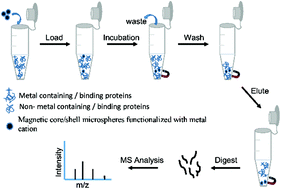Selective enrichment of metal-binding proteins based on magnetic core/shell microspheres functionalized with metal cations†
Abstract
Metal binding proteins play many important roles in a broad range of biological processes. Characterization of metal binding proteins is important for understanding their structure and biological functions, thus leading to a clear understanding of metal associated diseases. The present study is the first to investigate the effectiveness of magnetic microspheres functionalized with metal cations (Ca2+, Cu2+, Zn2+ and Fe3+) as the absorbent matrix in IMAC technology to enrich metal containing/binding proteins. The putative metal binding proteins in rat liver were then globally characterized by using this strategy which is very easy to handle and can capture a number of metal binding proteins effectively. In total, 185 putative metal binding proteins were identified from rat liver including some known less abundant and membrane-bound metal binding proteins such as Plcg1, Acsl5, etc. The identified proteins are involved in many important processes including binding, catalytic activity, translation elongation factor activity, electron carrier activity, and so on.


 Please wait while we load your content...
Please wait while we load your content...